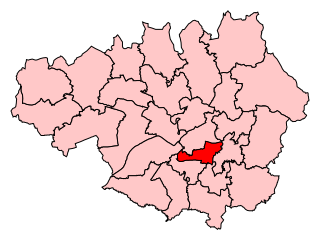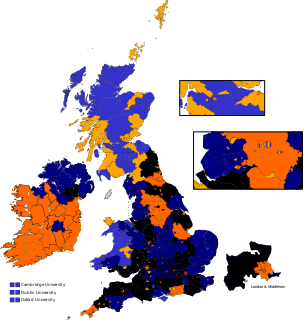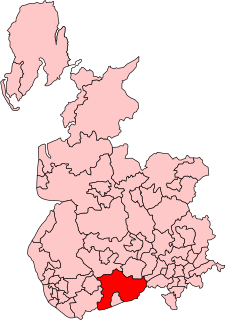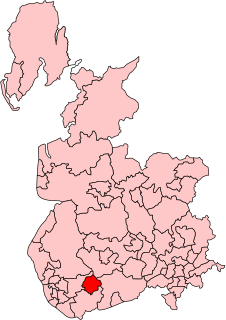
Blackburn is a constituency in Lancashire, England, which has been represented in the House of Commons of the UK Parliament since 2015 by Kate Hollern of the Labour Party. From 1979 to 2015, it was represented by Jack Straw who served under the Labour leaders of Neil Kinnock and John Smith and the Labour governments of Tony Blair and Gordon Brown.

Manchester Gorton is a constituency represented in the House of Commons of the UK Parliament by Labour's Afzal Khan, who was elected at the 2017 general election. It is the safest Labour seat in Greater Manchester by numerical majority and one of the safest in the country.

Stockport is a constituency represented in the House of Commons of the UK Parliament since 2019 by Navendu Mishra of the Labour Party.

Lancaster was a constituency of the House of Commons of the Parliament of England then of the Parliament of Great Britain from 1707 to 1800 and of the Parliament of the United Kingdom from 1801 to 1867, centred on the historic city of Lancaster in north-west England. It was represented by two Members of Parliament until the constituency was disenfranchised for corruption in 1867.

Accrington was a parliamentary constituency of the House of Commons of the Parliament of the United Kingdom from 1885 to 1983. It elected one Member of Parliament (MP) by the first-past-the-post system of election.

Ormskirk was a county constituency represented in the House of Commons of the Parliament of the United Kingdom. It elected one Member of Parliament (MP) by the first past the post system of election. It was created by the Redistribution of Seats Act 1885 as a division of the parliamentary county of Lancashire. The constituency boundaries were changed in 1918, 1950, 1955 and 1974.
Stalybridge officially sometimes written in early years as Staleybridge was a constituency represented in the House of Commons of the UK Parliament from 1868 until 1918 by one MP. It comprised the borough of Stalybridge which lay in Lancashire and Cheshire and which is in the east of today's Greater Manchester. On abolition for the 1918 general election under the Representation of the People Act 1918 the seat's main replacement became Stalybridge and Hyde.
The parliamentary borough of Finsbury was a constituency of the House of Commons of the UK Parliament from 1832 to 1885, and from 1918 to 1950. The constituency was first created in 1832 as one of seven two-seat "metropolis" parliamentary boroughs other than the two which already existed: Westminster and the City of London; the latter until 1885 retained an exceptional four seats. Finsbury was directly north of the City of London and was smaller than the Finsbury division of the Ossulstone hundred but took in land of Holborn division to its southwest in pre-introduction changes by Boundary Commissioners. It included Finsbury, Holborn, Moorfields, Clerkenwell, Islington, Stoke Newington and historic St Pancras. The 1918 constituency corresponded to the smaller Metropolitan Borough of Finsbury ; it was a seat, thus electing a single member, fulfilling a longstanding aim of Chartism which underscored the 1832 reforms.

Warrington was a parliamentary constituency in the United Kingdom. From 1832 to 1983 it returned one Member of Parliament (MP) to the House of Commons of the Parliament of the United Kingdom.

Rossendale was a parliamentary constituency in the Lancashire, England. Created in 1885, it elected one Member of Parliament (MP) to the House of Commons of the Parliament of the United Kingdom, elected by the first-past-the-post voting system. When created it comprised the districts of Rawtenstall, Bacup, and Haslingden; Ramsbottom district was added to the constituency in 1950.
Ince was a parliamentary constituency in England which elected one Member of Parliament (MP) to the House of Commons of the Parliament of the United Kingdom. It comprised the town of Ince-in-Makerfield and other towns south of Wigan.

Westmorland was a constituency covering the county of Westmorland in the North of England, which returned Members of Parliament to the House of Commons of the Parliament of the United Kingdom.

Newton was a parliamentary borough in the county of Lancashire, in England. It was represented by two Members of Parliament in the House of Commons of the Parliament of England from 1559 to 1706 then of the Parliament of Great Britain from 1707 to 1800 and of the Parliament of the United Kingdom from 1801 until its abolition in 1832.

North Lancashire was a county constituency of the House of Commons of the Parliament of the United Kingdom. It was represented by two Members of Parliament. The constituency was created by the Great Reform Act of 1832 by the splitting of Lancashire constituency into Northern and Southern divisions.
Heywood was a county constituency in the county of Lancashire of the House of Commons for the Parliament of the United Kingdom. Created by the Redistribution of Seats Act 1885, it was represented by one Member of Parliament. The constituency was abolished in 1918.
Middleton was a county constituency in the county of Lancashire of the House of Commons for the Parliament of the United Kingdom. Created by the Redistribution of Seats Act 1885, it was represented by one Member of Parliament. The constituency was abolished in 1918.

St Helens was a constituency in the county of Lancashire, England. It returned one Member of Parliament (MP) to the House of Commons of the UK Parliament.
Egremont was a parliamentary constituency centred on the town of Egremont in Cumberland. It returned one Member of Parliament (MP) to the House of Commons of the Parliament of the United Kingdom, elected by the first past the post system.
The Stalybridge by-election was a Parliamentary by-election. It returned one Member of Parliament (MP) to the House of Commons of the United Kingdom, elected by the first past the post voting system.
Joseph Bliss was a British Liberal Party politician.












